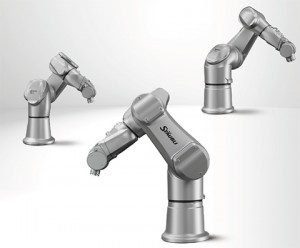Hygienic robots for aseptic pharmaceutical processes
 Stäubli has pioneered a number of developments in the pharmaceutical sector, including the Stericlean range of robots which have now become a mainstay in many pharmaceutical applications by facilitating automation within aseptic environments.
Stäubli has pioneered a number of developments in the pharmaceutical sector, including the Stericlean range of robots which have now become a mainstay in many pharmaceutical applications by facilitating automation within aseptic environments.
However, just as for any other manufacturing sector, the pharmaceutical industry continues to evolve to address multiple challenges such as new regulatory changes, an increased demand for personalised medicines, new treatment options, combined with innovative approaches in prevention and diagnostics.
Stäubli’s latest pioneering initiative is the new Stericlean+ range of robots. These new variants address the ever-increasing demands of the pharmaceutical sector, by providing validated solutions which meet the highest hygiene and cleanliness standards including biological resistance, VHP compatibility, cleaning media resistance and D Value performance.
Many of the new challenges faced by the pharmaceutical industry today require a change in manufacturing philosophy, towards that of greater levels of flexibility, making it possible to economically achieve smaller batch runs. This is where robot-based automation solutions, with their impressive levels of flexibility, are fast becoming the first choice for small batch production runs in personalised medicine. In addition to flexibility, robots provide the additional advantage of reducing human contact to a minimum, thereby avoiding the risk of contamination.
There are many pharmaceutical processes which can be automated, and to be able to respond efficiently to changing market demands, production must be easily scalable. The flexibility of the robot is a key factor in achieving these objectives. Whether in a small isolator with a single robot capable of handling several independent or linked operations, or within a complete production line equipped with multiple robots, they make it possible to change production easily, should the need arise.
Validated robot solutions
Across multiple industries, robots are generally defined according to their payload, reach and speed. In the pharmaceutical sector however, an essential fourth factor must be considered, that of the working environment and the cleaning processes which will be used on the systems.
Pharmaceutical manufacturing facilities are divided into several areas which have different specifications in terms of particulate emission and cleaning processes. Stäubli defines 4 levels of requirement, from the most restrictive Grade A Isolator, which is subjected to aggressive H2O2 cleaning, to logistic areas, through intermediate levels of inspection, restricted access barriers (RABs), and secondary packaging areas where equipment is meticulously cleaned with alcohol wipes.
The robots used in these areas must not only be suitable but also validated to operate within the environment. The new Stericlean+ range enables Stäubli to offer a full range of validated robots including the documentation package that is required to ensure compatibility, safety and consistency and ease the final acceptance of the whole system.
Aseptic design criteria
Decontamination processes are key within the pharmaceutical sector, especially within an isolator environment. Stäubli has performed the rigorous tests required to validate not only the robot, but also the materials used, together with evaluating performance using various cleaning media. To ensure adherence to the latest and most demanding standards, Stäubli partnered with SKAN, the world leader in manufacturing isolator systems, and a specialist within pharmaceutical and aseptic environments.
SKAN’s analytical services (SKANalytix) advised Stäubli on the aseptic design criteria of the robot. They also provide the much-needed validation and documentation package for the robot demanded by customers.
Hygienic design is a central aspect of a robot, establishing that it is suitable for working in an aseptic environment. Design specifics cover a wide range. There are two primary factors. First is the entire outer surface of the robot. If this cannot be adequately cleaned and decontaminated, then there is a risk that the aseptic processing conditions cannot be maintained. Appropriate materials need to be selected and the design should allow for easy access. Secondly, moving parts represent the greatest risk of particulate generation, so special attention needs to be given to the design and sealing of joints.
Specifically, there should be no gaps in joints in the robot’s outer shell, where micro-organisms could accumulate and grow. Surface roughness must have an Ra of no more than 0.8μm, to inhibit fungi or bacterial growth and also to enable efficient cleaning. The surface itself must be resistant to all cleaning and surface decontamination procedures, in particular vaporized hydrogen peroxide (H2O2) which is used for surface decontamination inside isolators.
Furthermore, the robot should only generate minimal turbulence in the laminar air flow as it moves. It is essential that any particles released during movement should remain at a low threshold, to guarantee that ISO 5 standards are adhered to. And finally, the robot must be easy to clean and decontaminate: all areas have to be accessible and easy to clean. There should be no areas where substances, particles or microorganisms can build up or pool.
Stäubli’s Stericlean TS2-60 and TX2-40, -60 and -90 robots have been subjected to SKANalytix’s intensive tests, with the collaboration resulting in the development of many new features for the Stericlean+ package that ensure that this range of robots are suitable for demanding aseptic manufacturing environments.
Visit the Stäubli Robotics website for more information
See all stories for Stäubli Robotics















